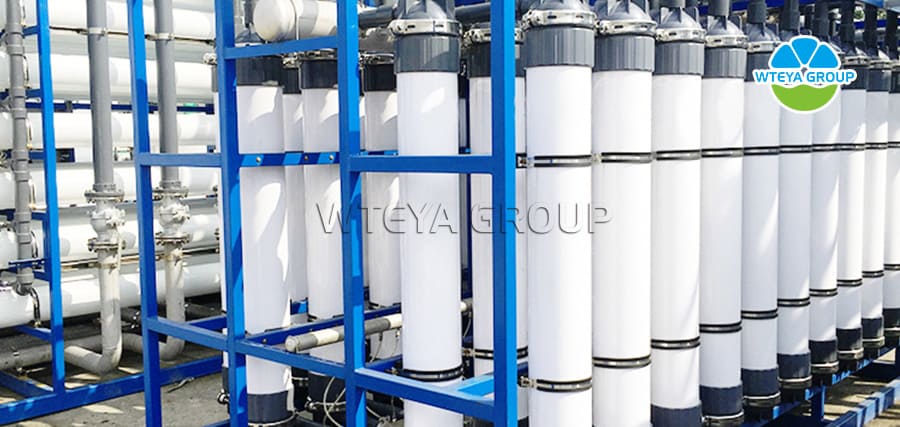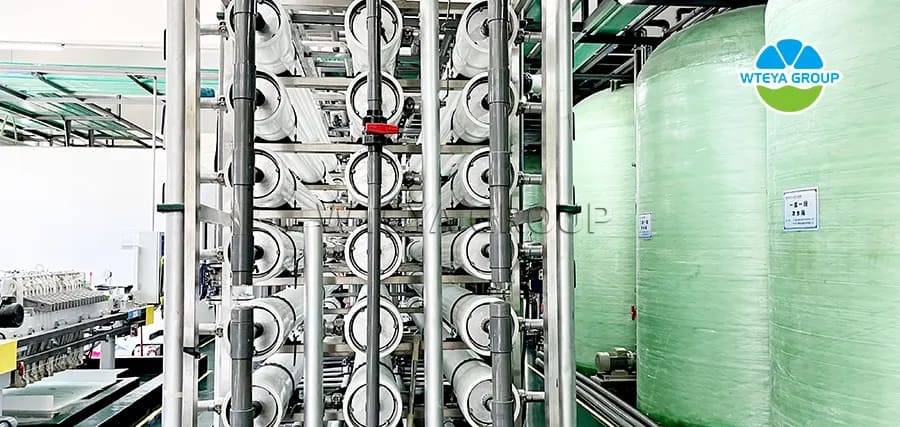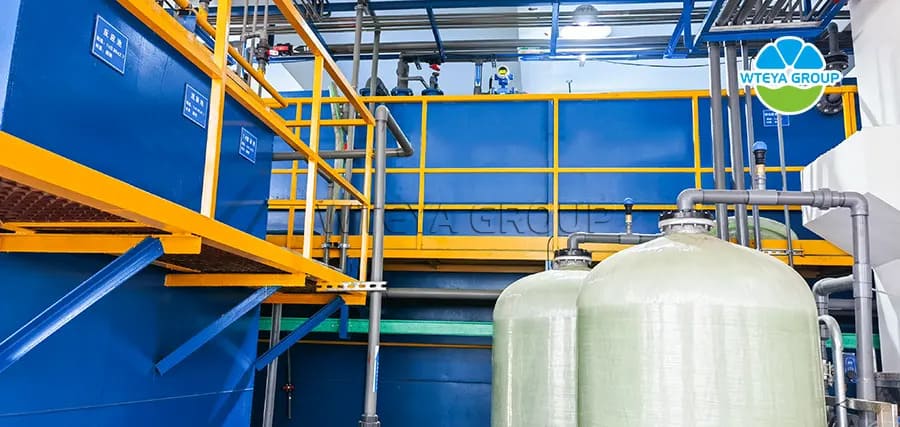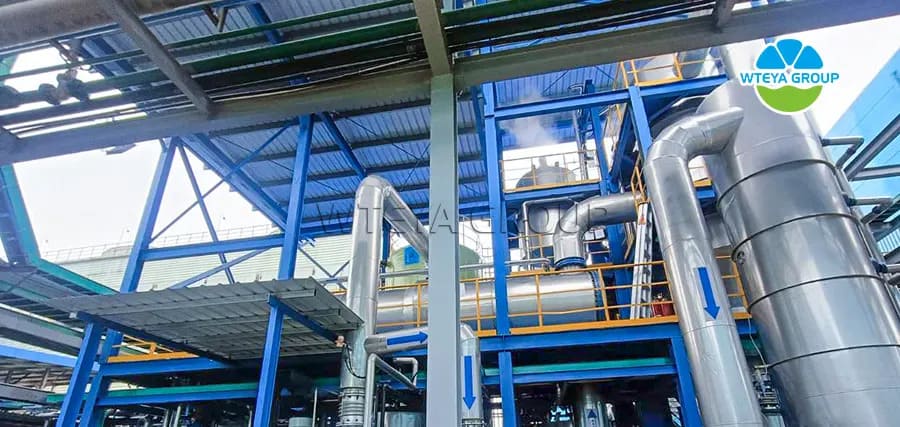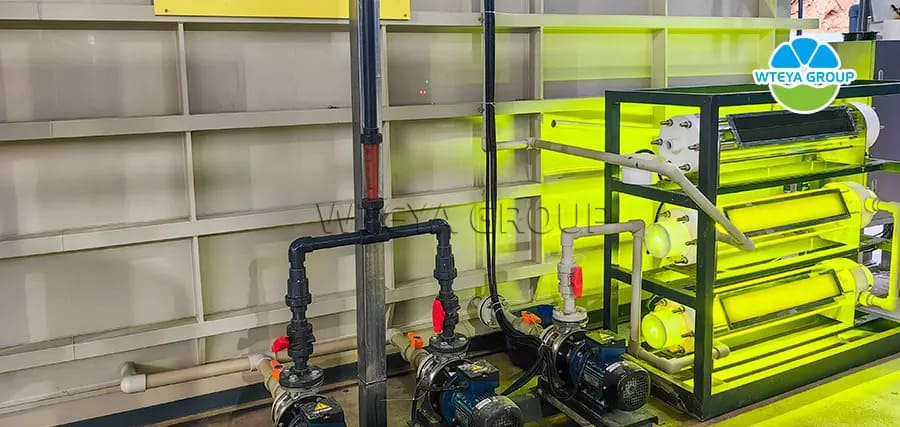PCB industry sewage treatment solutions
1. Ultrafiltration system (UF)
In the manufacturing industry
Before PCB manufacturing, raw water needs to be treated to remove suspended solids, microorganisms, gel and impurities that may affect the manufacturing process. Ultrafiltration systems can separate large molecules and particles, providing cleaner water for future treatment. In important products such as electroplating, chemical galvanizing, wastewater cleaning and treatment, microfiltration systems can provide the required pure water, while recovering and reusing some wastewater to reduce water waste.
Technical Principles
The technical principle of ultrafiltration (UF) system is based on membrane filtration technology, and the working core is a semi transparent membrane, also known as ultrafiltration membrane. This type of membrane has a small volume, usually between 0.01 and 0.1 micrometers, and can block large molecules, suspended particles, certain bacteria, and viruses in water.
When water and solutes pass through the membrane, water molecules and substances smaller than the membrane size can pass through the pores, while materials larger than the membrane size remain on the membrane surface. This process is called the "screening effect". Ultrafiltration membranes prevent substances that do not involve chemical reactions based on their physical size.
What achievements can we achieve?
Ultrafiltration system is a part of water quality treatment, which can effectively remove the molecular weight fraction of suspended solids, colloids, and organic matter in water. It is used for subsequent deep treatment, such as reverse osmosis, to reduce the burden and protect the film from premature pollution and blockage. Microfilters can recover and reuse some of the water used in cleaning and production processes, reduce water consumption, and improve the water reuse capacity of the entire production process.
2. Reverse osmosis (RO) system
In the manufacturing industry
In the PCB manufacturing process, a large amount of high-purity water is required to clean the circuit board, electroplating, moisture, and other aspects. The reverse osmosis system can remove ions, microorganisms, organic matter, and most dissolved solids from water, ensuring quality meets process requirements. The wastewater generated during the PCB manufacturing process contains heavy metals, chemicals, and other pollutants. Reverse osmosis technology can be used for the treatment and recovery of PCB waste. By removing these impurities, the pressure of the next treatment process can be reduced, and some water can be washed and returned to the production process for water reuse.
Technical Principles
The technical principle of reverse osmosis system is based on the use of semi permeable membranes to separate solvents and solutions. The pressure is higher than the osmotic pressure of the solution, and the pressure at which the solution (usually water) passes through the selective membrane. It has a very small opening, enough to allow water molecules to pass through, but it can block most ions, organic matter, and larger molecules such as bacteria and viruses. Therefore, when a mixture of water and impurities is pressurized into the reverse osmosis system, water molecules are pushed into the membrane and form clean water (permeate) through the pores in the membrane. The solution (such as salt and other impurities) is blocked on one side of the membrane to separate pure water and concentrated wastewater (concentrated water). In the reverse osmosis process, the selectivity and pressure of the membrane are important factors that determine the separation efficiency and water production quality of the system.
What achievements can we achieve?
Reverse osmosis systems can effectively remove ions, microorganisms, organic matter, and most dissolved solids from water, providing high-purity water for precise cleaning, electroplating, wet and etching processes. It can reduce the proportion of impurities on PCBs, reduce the proportion of defective products, and improve overall production quality. This is crucial for avoiding circuit short circuits and ensuring PCB quality. Meanwhile, the reverse osmosis system can treat wastewater containing heavy metals and other chemicals in the production process, clean some of the wastewater and reuse it during the production process, saving water and reducing production costs.
3. Integrated equipment
In the manufacturing industry
Integrated wastewater treatment equipment plays an important role in the PCB (printed circuit board) industry to effectively treat all wastewater produced in the industry. The PCB production line involves a series of chemical processing processes, including table grinding, etching, electroplating, metal holes, film development, and removal. These processes will generate wastewater containing high concentrations of heavy metals, organic solvents, acids and potassium, suspensions, and complex components such as surface substances. To ensure environmental protection, emission compliance, and resource reuse, integrated wastewater treatment equipment provides a comprehensive solution for multiple treatment units, specifically applied in the following areas:
(a) Classification and treatment of wastewater
The integrated equipment will classify the collected waste PCB circuits for the first time, as different waste materials need to be processed in different processes. The pre-treatment stage can include nets, water tanks, regulating tanks, etc., which are used to remove suspended large particles, regulate the pH value of wastewater and water flow, and create appropriate conditions for future treatment.
(b) Removing heavy metals
Polychlorinated biphenyls in wastewater contain heavy metal ions such as copper, nickel, lead, and chromium, which may pose a threat to the environment and human health. Integrated devices typically use technologies such as chemical deposition, ion exchange, membrane absorption or separation to remove heavy metals. For example, by adding sediment agents to generate heavy metal ions that are insoluble in sediment, and then removing them through solid and liquid separation devices (such as sediment storage tanks, airplanes); Or use chelating resin, activated carbon, and heavy metal ion absorption absorbent materials; In some cases, membrane separation techniques such as reverse osmosis (RO), filtration (NF), and other techniques are used for advanced treatment.
(c) Organic decomposition
The organic matter in circuit board wastewater mainly comes from cleaning agents, growth products, inks, etc. Integrated equipment typically includes biological treatment units such as anaerobic bioreactors, bioreactors (such as activated sludge, biofilms), or MBRs (membrane bioreactors), and utilizes microbial metabolism to convert organic matter into carbon dioxide and water. MBR integrated wastewater treatment equipment is particularly suitable for the treatment of waste containing polychlorinated biphenyl complex organic compounds due to its efficiency in separating solids and liquids and high water quality.
(d)Reusing water with waste gas
In order to save water and reduce emissions, integrated equipment usually integrates Chinese water reuse systems. After the above wastewater treatment, it is cleaned through technologies such as deep filtration (such as sand and activated carbon filtration) and separator membranes (such as ultrafiltration and reverse osmosis) to meet the reuse standards of clean production lines or other non drinking water targets. For high salt or high concentration organic wastewater that is difficult to decompose through traditional technologies, technologies such as crystal evaporation, electro filtration, and permeation can be used to achieve near zero discharge (ZLD).
Technical Principles
This equipment mainly uses natural waste and coagulation technology, filters, centrifuges, and biotechnology, as well as first, second, and third treatment technologies to treat wastewater.
What kind of results can we achieve
We can operate fully automatically without the need for anyone, saving a lot of labor; The removal efficiency of suspended (SS) can reach 80-95%, and the organic removal efficiency can reach over 80%.
4. Evaporation device
And in production
The evaporation equipment in industrial circuit board PCBs (printed circuit boards, printed circuit boards) is mainly used to treat wastewater with high salt and high organic wastewater concentration, in order to reduce wastewater discharge, resource recovery, and near zero emissions (zero liquid energy, ZLD). During the production process of polychlorinated biphenyls, especially in electroplating, etching, and development, high concentrations of heavy metal salts, organic solvents, representative surfaces, and other wastewater components are generated. Among them, high salinity can cause serious environmental pollution if directly discharged. As an important equipment for deep wastewater treatment, the application of evaporation equipment in the PCB circuit industry mainly includes the following aspects:
(a) Evaporation concentration of high salinity wastewater
Evaporation devices (such as evaporators, steam compression steam engines (MVR), steam compression steam (TVR), etc.) use a wastewater heating system to evaporate the water inside, causing the wastewater to evaporate to a near saturated position, greatly reducing the volume and amount of wastewater. This is of great significance in reducing the difficulty of subsequent wastewater treatment, lowering the cost of wastewater treatment, and ultimately lowering the cost of wastewater treatment.
(b) Crystal salt and resource recovery
After crystallization cooling or salt concentration of high salinity wastewater, inorganic salts (such as sulfates, chlorides, nitrates, etc.) can be separated to form salt crystals. After treatment, some of these salt crystals can be sold as by-products for resource recovery; The parts that cannot be recycled need to be safely disposed of according to regulations to avoid causing secondary environmental pollution.
(iii) Organic concentration and recovery
For high organic concentration wastewater, steam equipment can classify organic matter and water, concentrate organic solutions into refining, extraction, adsorption and other technologies, recover valuable organic components such as cleaning agents and solvents, reduce production costs, and achieve circular economy.
(iv) Near air emissions (ZLD)
In areas with strict environmental requirements or water scarcity, polychlorinated biphenyl enterprises may need to achieve almost zero discharge of wastewater. The evaporation device, combined with crystallization, drying and other technologies, can almost remove water from wastewater, leaving only solid waste, achieving the goal of zero wastewater discharge. This not only helps companies meet strict environmental protection regulations, but also helps to protect water resources and sustainable development.
(v) Waste heat and energy conservation
Modern evaporation equipment design focuses on energy efficiency, using various evaporation efficiency, compressed steam and other technologies to utilize evaporative steam as an efficient heat source, achieving stepped energy utilization and greatly reducing energy consumption. In addition, some equipment can be combined with the factory's waste heat recovery system, using waste heat from the production process as a heat source for evaporation, further saving energy.
Technical Principles
MVR evaporator: The evaporator reuses the energy generated by its own secondary steam to reduce the demand for external energy. The operation process of MVR is to compress steam in the refrigeration compressor, increase temperature, pressure, and temperature, and then enter the heating and condensing system to utilize the potential temperature of steam. Except for the drive start, no steam is discharged from the second steam of the evaporator during the entire evaporation process. It is compressed by the compressor, causing an increase in pressure and temperature. The steam is then sent to the heating chamber to maintain liquid boiling.
Forced evaporation device circulation: The circulation of solution in the device mainly relies on the forced flow generated by external forces. The cycle speed is usually between 1.5 and 3.5 meters per second. Thermal energy and production capacity. The raw material liquid is pumped upwards from the bottom by a circulating pump, which flows upwards in the pipeline of the heating chamber. The mixture of steam and liquid foam enters the evaporation chamber and is separated. The steam is discharged from the top, the blocked liquid drops, is sucked into the conical bottom by the circulating pump, and then enters the heating pipe for further circulation. It has heat transfer coefficient, salt resistance, soil resistance, strong adaptability, and is easy to clean. Suitable for industries such as scale, crystal, temperature sensitive (low temperature), high concentration, and high viscosity, including chemically insoluble solids, food, pharmaceuticals, environmental protection technology, and evaporation recovery.
Cold evaporator: The temperature of the cold evaporator refers to the normal operation of woodworking evaporation at 35 to 50 ℃. After arriving at Ye Wei, solidification is carried out in each bucket of water, and the pump works to generate a vacuum. She is operated by the automatic water and evaporator - YaSuji, which generates heat to evaporate and heat the wastewater. The wastewater is in a zero vacuum state, and the temperature of the wastewater rises to around 30 ℃. The wastewater begins to evaporate before completion. After evaporation, YaSuJi sets the temperature to 35-40 ℃ and compresses the local area network with cold water to generate temperature. While the water rapidly evaporates, it cools the local area network through an expansion valve and wants to operate the heat absorption system after evaporation, rising to cold steam. The odor decomposition solution is dissolved in ChuShuiGuan, and of course, it is compressed and absorbed by YaSuJi ZhiRe to absorb both hot and cold, just reheat the wastewater. If the bubble is detected by the sensor during the evaporation process, the defoamer will automatically add defoamer. After one cycle is completed, the concentrate will be discharged (the cycle time can be set). After the evaporation cycle is completed, the compression pump stops working, focuses on the open pneumatic valve tube, pressurizes and evaporates, and focuses the hydraulic pressure on the barrel.
What kind of results can we achieve
Our company's evaporator can reach a concentration of 5-100 times under different water quality conditions, making it more energy-efficient, easy to adapt, highly automated, environmentally safe and stable. It has been widely used in industries such as chemical, pharmaceutical, food, and environmental fields.
5. ECC catalytic equipment:
Application in production
The chemical catalytic chemical equipment in the circuit PCB industry is mainly used for organic wastewater treatment. Through catalytic chemical processes, organic pollutants are effectively decomposed, reducing their impact on the environment and ensuring that waste meets standards. The use of these devices and technologies is crucial for improving the wastewater treatment efficiency of the PCB industry, achieving environmental goals, and promoting the development of green industries. The specific applications are as follows:
(a) Organic wastewater treatment
PCBs generate wastewater containing organic solvents, metabolites, plastics, preservatives, and other organic substances during manufacturing, cleaning, development, film production, and other processes. Catalytic oxidation equipment, such as electrocatalytic oxidation (ECO), ozone oxidation (OCO), Fenden oxidation, etc., use catalysts to accelerate chemical reactions between organic matter and oxidants (such as oxygen, ozone, hydrogen peroxide) under specific conditions, converting them into toxic or low concentration substances such as carbon dioxide, water, and inorganic salts. These technologies can effectively decompose organic compounds that are difficult to decompose in polychlorinated biphenyl wastewater, improve the chemical substances in the wastewater, promote further chemical treatment or deep treatment, and ensure that the waste meets the standards.
(b) Wastewater treatment of heavy metals
Although catalytic oxidation equipment mainly targets organic pollutants, in some cases, such as in the OH Fenton oxidation process, it can also help oxidize some heavy metal ions, transforming them into sedimentary states, and helping to remove heavy metals. However, for the PCB industry that produces high concentration heavy metal wastewater, it is usually necessary to combine professional techniques such as chemical deposition, ion exchange, absorption, separation membranes, and heavy metal treatment to effectively treat it.
(iii) Joint wastewater treatment
In fact, catalytic equipment can be used in conjunction with other wastewater treatment technologies (such as biological treatment, membrane separation, adsorption, etc.) to form a combined process to jointly treat complex wastewater in the PCB industry. For example, by effectively catalyzing the oxidation and decomposition of difficult to decompose organic matter in wastewater, the bioavailability can be improved, and then biological treatment can be carried out to remove organic matter and ammonia nitrogen; Alternatively, in the deep treatment stage, catalytic chemical technology can be used to filter the wastewater after initial treatment to ensure standard water quality.
Technical Principles
ECC catalytic oxidation technology is a new technology developed by the company, which uses catalysts to promote the oxidation reaction between organic pollutants and oxides (such as oxygen, ozone, hydrogen peroxide, etc.) under specific conditions. The final product is harmless or low toxic, achieving pollutant removal effect. The oxidation catalytic equipment varies according to different applications and objects, using different oxidants, catalysts, and reaction conditions to meet practical needs.
What kind of results can we achieve
The efficiency of company type organic removal products (CODcr) exceeds 80%, and some can exceed 95%. It can also significantly reduce the heating temperature of the reactor, the probability of steam device bubbles, and system membrane fouling.








